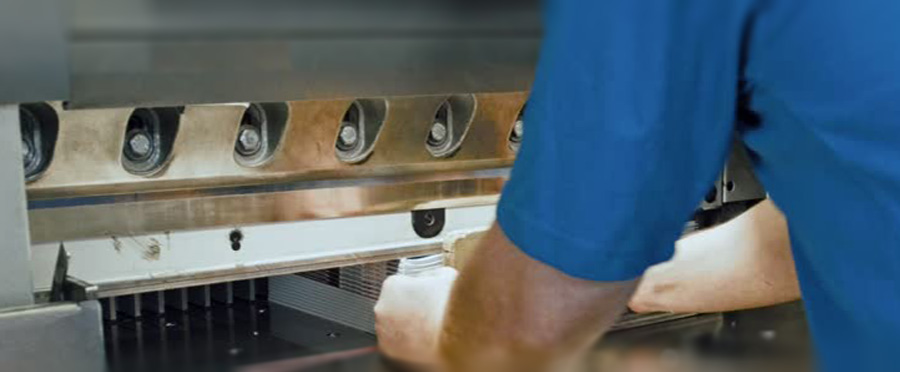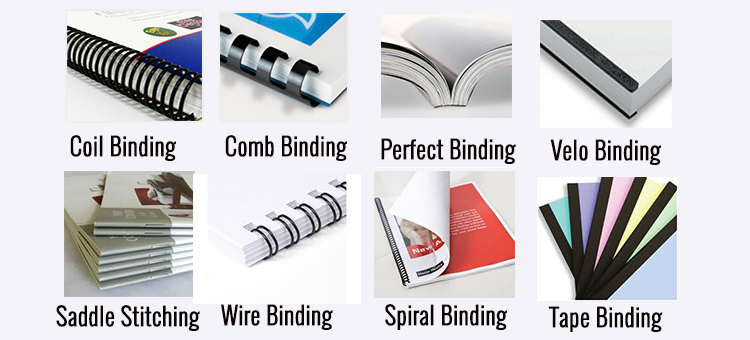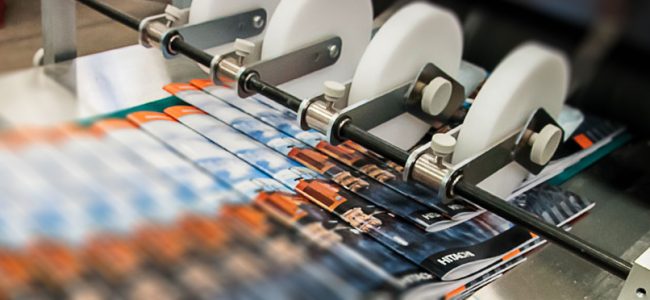Ar MahaMeru Bali Printing, the finishing refers to all the activities that are performed on printed material after printing. This includes binding, the fastening of individual sheets together, and decorative processes such as die-stamping, embossing or laminating. Finishing can be: an in-line process – which means that units attached to the end of the printing press perform the finishing operations. This is typically the case with web presses as well as many digital presses. An off-line process – which means that printing and finishing are completely separate processes.
The overview below list major finishing processes.
Cutting and trimming
 Paper stock may need to be cut or trimmed more than once during the production of a job:
Paper stock may need to be cut or trimmed more than once during the production of a job:
- Sometimes the paper that is in stock is too big and needs to be trimmed prior to printing a job.
- When multiple signatures are combined on one press sheet, those sheets need to be cut after printing.
- Sheets may need to be trimmed to fit folding machines or other bindery equipment.
- After folding and binding the unbound sides need to be trimmed. For books, this is often done with a three-knife cutter, which has three blades to simultaneously trim three sides.
Cutting and trimming are usually done using a guillotine cutter. A stack of sheets is placed on the bed of the cutter and the angled stainless steel blade cuts through it at the desired position. All the stacks are subsequently often placed in a jogger, a vibrating table that squares the stacks of sheets.
Folding
For magazines, books,… large press sheets need to be folded into signatures. This involves a series of right-angle folds in which the sheet is folded multiple times. Folding a sheet once makes four pages, two right-angle folds make eight pages,…
Other types of work require parallel folds in which two or more folds which are oriented in the same direction are made in a sheet. This is typically done for leaflets or brochures.
There are two common types of folding machines: the knife folder, also known as a right-angle folder, and the buckle folder. In general knife folders are used for heavier stocks, while buckle folders are used for lighter paper types.
Collating and gathering
These processes involve placing (folded) sheets in the correct sequence. Collating refers to sorting individual sheets into sets. Many laser printers and copiers have a collating function. Gathering is a similar process but it involves folded signatures. Gathering machines have up to thirty slots or pockets in which signatures are fed manually or automatically. The machine then gathers the signatures into what is known as a book block. Such machines can also have a binding function, such as for instance a stitcher.
Binding

There are different ways of binding sheets together. Below are the most commonly used techniques:
- Perfect binding: Pages are fixed to a cover or spine using glue. This process is used for paperback books, magazines, telephone guides,…
- Saddle-stitching: Pages are bound by driving staples through the center of the spine of folded sheets. This wire binding technique is commonly used for Booklet, magazines, newsletters, small catalogs,… but is limited in the number of pages that can be bound.
- Thread sewing: A thread or cord is used to stitch a book block together. This is often done in conjunction with using an adhesive. Thread sewing is used for hardcover books. Afterward the book cover is attached using a technique called case binding. As with wire binding, there are two types of thread sewing: saddle-sewing and side-sewing.
- Comb binding: The teeth of a plastic ‘comb’ are inserted into a series of slits drilled or punched into a stack of sheets. This process is often used for reports and presentations.
Spiral binding: A continuous wire or plastic coil is threaded through holes drilled or punched into a stack of sheets. Spiral binding is typically used for notebooks. - Loose-leaf binding: A set of holes is drilled in a stack of sheets which are then inserted into standard or customized ring binders or post binders. This binding technique is used for notebooks, presentations, financial reports, manuals or any other type of publication that require frequent updating.
- Padding: the binding of a stack of sheets using a flexible adhesive so that the sheets can easily be removed. Notepads are a typical example of padding.
